FRANK Solutions for Class 10 Physics Chapter 1 - Force, Work, Energy and Power - Exercises and MCQ
Chapter 1 - Force, Work, Energy and Power - Exercises and MCQ Exercise 56
Question 1
What do you mean by the turning effect of a force?
Solution 1
The turning effect produced by a force on a rigid body about a point, pivot or fulcrum is called the moment of force or torque. It is measured by the product of force and the perpendicular distance of the pivot from the line of action of force.
Moment of a force = Force x perpendicular distance of the pivot from the force.
Its SI unit is newton-metre (Nm).
Moment of a force = Force x perpendicular distance of the pivot from the force.
Its SI unit is newton-metre (Nm).
Question 2
What is the difference between mass and weight?
Solution 2

Question 3
The moment of a force of 20 N about a fixed point 0 is 10 Nm. Calculate the distance of the point 0 from the line of action of the force.
Solution 3

Question 4
What is meant by the term 'center of gravity of a body'?
Solution 4
The point through which the resultant of the weights of all the particles of the body acts is called its centre of gravity
Question 5
Where is the centre of gravity of a uniform ring situated?
Solution 5
The centre of gravity of a uniform ring is situated at the centre of the ring.
Question 6
State the factors on which the centre of gravity of a body depends.
Solution 6
The centre of gravity of a body depends upon:
(i) Body's weight
(ii) Body's shape
(i) Body's weight
(ii) Body's shape
Question 7
Can the centre of gravity be situated outside the material of the body? Give an example.
Solution 7
Yes, the centre of gravity of a body can be outside it. The CG of a uniform ring is at its centre, a point which is not on the body.
Question 8
Fig. 1 shows five pieces of cardboard of uniform thickness cut into different shapes. On each diagram draw two lines to indicate the position of centre of gravity G.


Solution 8
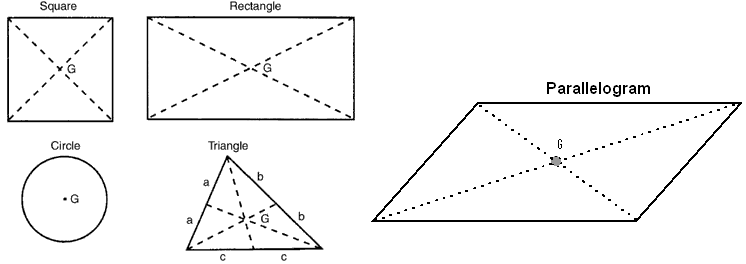
Question 9
Name the physical quantity whose SI unit is Nm.
Solution 9
The physical quantity is 'torque'.
Question 10
What is meant by a torque?
Solution 10
The turning effect produced by a force on a rigid body about a point, pivot or fulcrum is called the moment of force or torque. It is measured by the product of force and the perpendicular distance of the pivot from the line of action of force.
Question 11
A body is pivoted at a point. A force of 10 N is applied at a distance of 30 cm from the pivot. Find the moment of force about the pivot.
Solution 11
Question 12
Is moment of a force a scalar quantity?
Solution 12
No, the moment of force is a vector quantity.
Question 13
Is it easier to turn a steering wheel of large diameter than that of small diameter? Why?
Solution 13
A larger diameter provides a greater torque (= force x perpendicular distance); hence, it is easier to turn a steering wheel of a large diameter than that of a small diameter.
Question 14
Define the centre of gravity of a body.
Solution 14
The point through which the resultant of the weights of all the particles of the body acts is called its centre of gravity
Question 15
What is meant by equilibrium?
Solution 15
A body is said to be in equilibrium under the action of a number of forces, if the forces are not able to produce any change in the state of rest or of uniform motion or uniform rotation.
Question 16
What is meant by the principle of moments?
Solution 16
Principle of moments: If a body is in equilibrium under the action of number of force, then the sum of clockwise moments is equal to the sum of anticlockwise moments.
Chapter 1 - Force, Work, Energy and Power - Exercises and MCQ Exercise 57
Question 1
What is meant by a centripetal force? Is it same as centrifugal force?
Solution 1
Centripetal force: Whenever a body is moving in a circular path with a uniform speed, its velocity is continuously changing due to change in its direction. The body thus possesses acceleration and this acceleration is called centripetal acceleration. The force which produces this acceleration is called centripetal force. It acts along the radius towards the centre of the circular path.
It is not the same as the centrifugal force.
It is not the same as the centrifugal force.
Question 2
Name the physical quantity whose unit is kgfm. Define it.
Solution 2
The physical quantity is 'torque'.
Torque may be defines as the turning effect produced by a force on a rigid body about a point, pivot or fulcrum. It is measured by the product of force and the perpendicular distance of the pivot from the line of action of force.
Torque may be defines as the turning effect produced by a force on a rigid body about a point, pivot or fulcrum. It is measured by the product of force and the perpendicular distance of the pivot from the line of action of force.
Question 3
What is meant by the turning effect of force? Give two examples.
Solution 3
The turning effect produced by a force on a rigid body about a point, pivot or fulcrum is called the moment of force or torque. It is measured by the product of force and the perpendicular distance of the pivot from the line of action of force.
Examples of turning effect of force:
(i) Turning a steering wheel
(ii) Tightening a cap
Examples of turning effect of force:
(i) Turning a steering wheel
(ii) Tightening a cap
Question 4
What is meant by the state of equilibrium of a body?
Solution 4
A body is said to be in equilibrium under the action of a number of forces, if the forces are not able to produce any change in the state of rest or of uniform motion or uniform rotation.
Question 5
What is the difference between static and dynamic equilibrium?
Solution 5
Equilibrium in any case requires the ? forces acting on an object = 0, i.e. that there is
Fnet = 0.
Static equilibrium is the situation where the object upon which the forces act is no moving.
The object is "static" hence the state of equilibrium gets its name.
Dynamic equilibrium is the situation where an object is in constant velocity motion.
{This object can't experience an acceleration which means Fnet >0}
Fnet = 0.
Static equilibrium is the situation where the object upon which the forces act is no moving.
The object is "static" hence the state of equilibrium gets its name.
Dynamic equilibrium is the situation where an object is in constant velocity motion.
{This object can't experience an acceleration which means Fnet >0}
Question 6
State the conditions of a stable equilibrium of a body.
Solution 6
When the centre of gravity is nearer to the base of a body, the body is in stable equilibrium.
Conditions for stable equilibrium:
(a) The body should have a broad base.
(b) Centre of gravity of the body should be as low as possible.
(c) Vertical line drawn from the centre of gravity should fall within the base of the support.
Conditions for stable equilibrium:
(a) The body should have a broad base.
(b) Centre of gravity of the body should be as low as possible.
(c) Vertical line drawn from the centre of gravity should fall within the base of the support.
Question 7
A body is acted upon by two forces, each of magnitude F, but in opposite directions. State the effect of the forces when
(a) Both forces act at the same point of the body.
(b) The two forces act at two different points of the body at a separation d.
(a) Both forces act at the same point of the body.
(b) The two forces act at two different points of the body at a separation d.
Solution 7
(a) If both the forces act at the same point of the body, they have the same line of action, and then the moment becomes zero.
(b) If both the forces act at two different points of the body at a separation d then they constitute a torque whose value is given F x d.
(b) If both the forces act at two different points of the body at a separation d then they constitute a torque whose value is given F x d.
Question 8
A wheel of diameter 3 m is shown in fig. 2 with axle at 0. A force F = 8 N is applied at Q in the direction shown in figure. Calculate the moment of force about:
(i) centre o, and
(ii) point p.
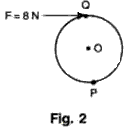
(i) centre o, and
(ii) point p.

Solution 8

Question 9
Calculate the resultant moment of forces about O and state its direction in fig. 3.


Solution 9

Question 10
State the principle of moments. A meter scale is pivoted at 30 cm mark and it is in equilibrium when a mass of 40 g is suspended from 10 cm mark. Calculate the mass of the ruler.
Solution 10

Question 11
A meter scale is provided at its mid-point when the various masses are suspended on it as shown in fig. 4. from which point will you suspend a 50 g mass in order to keep the ruler in equilibrium?


Solution 11

Question 12
Fig. 5 shows a uniform meter scale weighing 200 gf. Provided at its centre. Two weights 300 gf and 500 gf are suspended from the ruler as shown in the diagram. Calculate the resultant torque of the ruler and hence calculate the distance from mid-point where a 100 gf should be suspended to balance the meter scale.
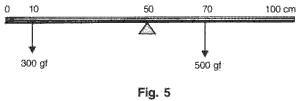

Solution 12
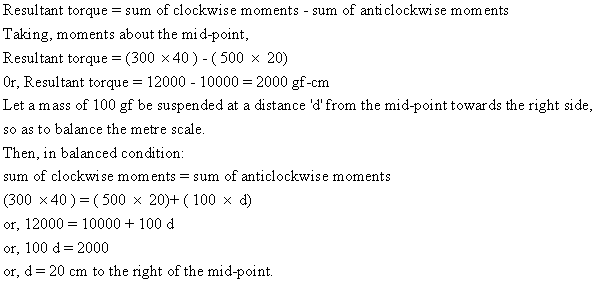
Question 13
A meter scale is pivoted at its mid point and a 50 g mass suspended from the 20 cm mark. What mass balances the ruler when suspended from 65 cm mark?
Solution 13

Question 14
What do you mean by the state of equilibrium? What are the conditions for stable equilibrium?
Solution 14
A body is said to be in equilibrium under the action of a number of forces, if the forces are not able to produce any change in the state of rest or of uniform motion or uniform rotation.
Conditions for stable equilibrium:
(a) The body should have a broad base.
(b) Centre of gravity of the body should be as low as possible.
(c) Vertical line drawn from the centre of gravity should fall within the base of the support.
Conditions for stable equilibrium:
(a) The body should have a broad base.
(b) Centre of gravity of the body should be as low as possible.
(c) Vertical line drawn from the centre of gravity should fall within the base of the support.
Chapter 1 - Force, Work, Energy and Power - Exercises and MCQ Exercise 58
Question 1
Fig. 6 shows the dimensions of an acute angled triangle. By geometrical construction mark the C.G. of the triangle.
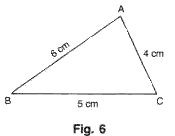

Solution 1
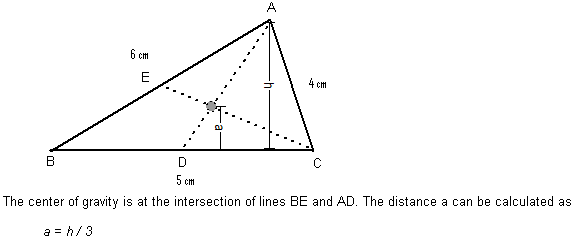
Question 2
A right-angled triangle cardboard piece is placed as shown in fig. 7. Redraw the diagram showing the relative position of the vertices of the triangle when it is suspended by a pin from the hole A. Explain why the position changes?
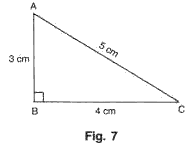

Solution 2
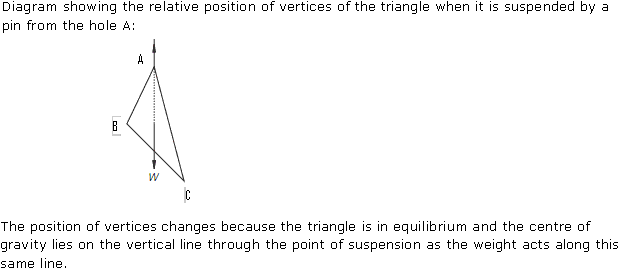
Question 3
Give scientific reasons for the following:
(i) It is easier to push a boy standing on one leg than on both legs.
(ii) When a man climbs a slope he bends forward.
(iii) There are chances of toppling when a truck takes a sharp turn especially when it is not fully loaded.
(iv) A man runs in the direction of train while getting down from a moving train.
(v) Passengers in a bus are pushed backward when it starts suddenly.
(i) It is easier to push a boy standing on one leg than on both legs.
(ii) When a man climbs a slope he bends forward.
(iii) There are chances of toppling when a truck takes a sharp turn especially when it is not fully loaded.
(iv) A man runs in the direction of train while getting down from a moving train.
(v) Passengers in a bus are pushed backward when it starts suddenly.
Solution 3
(i) We keep our body balanced on two feet by keeping the center of gravity of our body between our feet. It acts normal to the sea level vertically downwards. If COG goes out we fall or we get unbalanced.
A boy standing on both legs has his COG in balanced position and is thus in stable equilibrium but a boy standing on one leg has his COG in unbalanced position which makes him quite unstable and hence it is easier to push him.
(ii) A man bends forward in order to keep himself in a stable equilibrium while climbing up a slope. By bending forward he increases the base of the support, so that the vertical line passing through his centre of gravity may still fall within the base.
(iii) When a truck is not fully loaded, its COG is at a high point and hence the turning moment of the weight is much greater, thus, the truck will be quite unstable and there are chances of toppling, when a truck takes a sharp turn.
(iv) When a man gets down from a moving train, his feet come to rest immediately, while the upper part of his body due to inertia of motion still remains in motion and consequently he leans in forward direction. The person while getting down of a train should run forward in the direction of the moving train to avoid fall.
(v) This is due to the fact that the body of the passenger is in the state of rest as long as the bus is at rest. When the bus starts, his feet acquire the velocity of the bus and come to motion with the moving bus, while the upper portion of his body due to inertia of rest tends to remain in the state of rest, resulting in his tendency to fall backwards.
A boy standing on both legs has his COG in balanced position and is thus in stable equilibrium but a boy standing on one leg has his COG in unbalanced position which makes him quite unstable and hence it is easier to push him.
(ii) A man bends forward in order to keep himself in a stable equilibrium while climbing up a slope. By bending forward he increases the base of the support, so that the vertical line passing through his centre of gravity may still fall within the base.
(iii) When a truck is not fully loaded, its COG is at a high point and hence the turning moment of the weight is much greater, thus, the truck will be quite unstable and there are chances of toppling, when a truck takes a sharp turn.
(iv) When a man gets down from a moving train, his feet come to rest immediately, while the upper part of his body due to inertia of motion still remains in motion and consequently he leans in forward direction. The person while getting down of a train should run forward in the direction of the moving train to avoid fall.
(v) This is due to the fact that the body of the passenger is in the state of rest as long as the bus is at rest. When the bus starts, his feet acquire the velocity of the bus and come to motion with the moving bus, while the upper portion of his body due to inertia of rest tends to remain in the state of rest, resulting in his tendency to fall backwards.
Question 4
What are the different methods by which you can increase the stability of a body?
Solution 4
To increase the stability of a body, its base should be made broad and heavy, and the centre of gravity of the body should be lowered.
Question 5
(i) What do you understand by the term couple of forces?
(ii) Calculate the moment of a couple shown in fig. 8.

(ii) Calculate the moment of a couple shown in fig. 8.

Solution 5
(i) Two equal and opposite parallel forces acting along different lines on a body constitute a couple.(ii)

Question 6
Give scientific reasons for the following:
(i) Even though the Tower of Pisa is leaning through an angle it does not fall.
(ii) While climbing a hill you will try to bend your body forward.
(iii) In a moving bus the standing passenger stands keeping both his legs apart.
(iv) In a doubled decker bus passengers are not allowed to stand in the upper deck.
(i) Even though the Tower of Pisa is leaning through an angle it does not fall.
(ii) While climbing a hill you will try to bend your body forward.
(iii) In a moving bus the standing passenger stands keeping both his legs apart.
(iv) In a doubled decker bus passengers are not allowed to stand in the upper deck.
Solution 6
(i) Leaning tower of Pisa is stable because a line through the centre of gravity falls within the structure's base. If the line falls outside the structure's base then there is a possibility that overturning will occur. This structure could be classified as unstable.
(ii) We bend forward in order to keep ourselves in a stable equilibrium while climbing up a hill. By bending forward we increases the base of the support, so that the vertical line passing through our centre of gravity still falls within the base.
(iii) By keeping the legs apart, the base of the body broadens, thus the C.G. lowers and the body attains a more stable equilibrium.
(iv) Passengers are usually advised not to stand in the upper deck of the double deck bus. When the passengers are standing, the C.G. rises. This decreases the stability of the bus. When the passengers are sitting, the C.G. gets lowered and stability of the bus increases.
(ii) We bend forward in order to keep ourselves in a stable equilibrium while climbing up a hill. By bending forward we increases the base of the support, so that the vertical line passing through our centre of gravity still falls within the base.
(iii) By keeping the legs apart, the base of the body broadens, thus the C.G. lowers and the body attains a more stable equilibrium.
(iv) Passengers are usually advised not to stand in the upper deck of the double deck bus. When the passengers are standing, the C.G. rises. This decreases the stability of the bus. When the passengers are sitting, the C.G. gets lowered and stability of the bus increases.
Question 7
Three forces A, B and C are acting on a rigid body which can turn about O in fig.9. If all the three forces are applied simultaneously, in which direction will the body move? Explain.
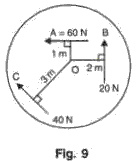

Solution 7

Question 8
Fig. 10 shows a uniform meter scale weighing 100 N pivoted at its centre. Two weights of 500 N and 300 N are hung from the ruler as shown in fig. 10.

(i) Calculate total clockwise and anticlockwise moments.
(ii) Calculate difference in clockwise moment and anticlockwise moment.
(iii) Calculate the distance from O where a 100 N weight should be suspended to balance the meter scale.

(i) Calculate total clockwise and anticlockwise moments.
(ii) Calculate difference in clockwise moment and anticlockwise moment.
(iii) Calculate the distance from O where a 100 N weight should be suspended to balance the meter scale.
Solution 8
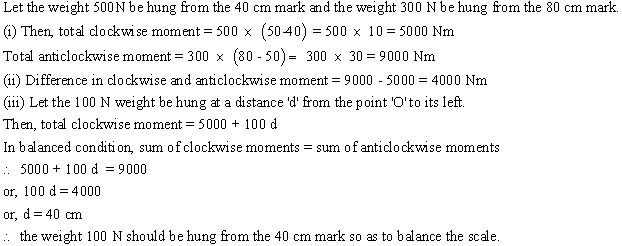
Question 9
A meter scale is provided at 10 cm mark and is balanced by suspending 400 g from 0 cm mark (fig. 11). Calculate the mass of meter scale.


Solution 9

Chapter 1 - Force, Work, Energy and Power - Exercises and MCQ Exercise 59
Question 1
(a) Define the term work.
(b) Name the CGS and SI unit of work.
(b) Name the CGS and SI unit of work.
Solution 1
'Work' is said to be done when the applied force makes the body move i.e., there is a displacement of body.
It is equal to the product of force and the displacement of the point of application of the force in the direction of force.
The SI unit of work is 'joules' and the CGS unit is 'erg'.
It is equal to the product of force and the displacement of the point of application of the force in the direction of force.
The SI unit of work is 'joules' and the CGS unit is 'erg'.
Question 2
The following are some of the energy transformations.
A. Electrical to light
B. Work to heat
C. Chemical to light
D. Electrical to sound
E. Mechanical to electrical
Identify the energy transformation that takes place in the following by inserting the corresponding letter in the shape provided.
(i) A candle flame
(ii) A torch is lighted
(iii) A microphone is used in a meeting
(iv) A cycle dynamo
(v) A piece of metal is being filed
A. Electrical to light
B. Work to heat
C. Chemical to light
D. Electrical to sound
E. Mechanical to electrical
Identify the energy transformation that takes place in the following by inserting the corresponding letter in the shape provided.
(i) A candle flame
(ii) A torch is lighted
(iii) A microphone is used in a meeting
(iv) A cycle dynamo
(v) A piece of metal is being filed
Solution 2
(i) [C]
(ii) [A]
(iii) [D]
(iv) [E]
(v) [B]
(ii) [A]
(iii) [D]
(iv) [E]
(v) [B]
Question 3
A boy pulls a box up to 10 m with a force of 5 kgf. Calculate the work done by him.
Solution 3

Question 4
Calculate the amount of work done by a child carrying a bag of 20 kg when he moves a distance of 40 m in
(a) Vertical direction, and
(b) Horizontal direction
(a) Vertical direction, and
(b) Horizontal direction
Solution 4
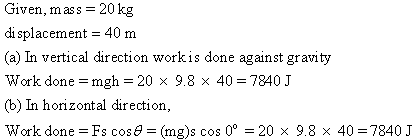
Question 5
(a) Define power and name its unit.
(b) A girl weighting 50 kg climbs up 60 steps each of 20 cm height in 5 minutes. Calculate the power developed.
(b) A girl weighting 50 kg climbs up 60 steps each of 20 cm height in 5 minutes. Calculate the power developed.
Solution 5
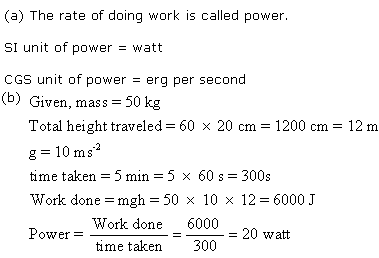
Question 6
Define energy and name its unit.
Solution 6
The energy of a body is its capacity to do work.
The SI unit of work is 'joules' and the CGS unit is 'erg'.
The SI unit of work is 'joules' and the CGS unit is 'erg'.
Question 7
When an elevator starts to move down suddenly we experience 'weightlessness'. Explain.
Solution 7
When an elevator begins to move downwards in an accelerated mode, the forces acting on the body are the following:
a.Weight of the body acting downwards
b.Normal reaction of the floor acting upwards
c.The centrifugal force acting on the body, acting upwards.
Weight of the body is due to gravitational force on the body acting downwards.
Normal reaction is the force that is exerted by the elevator floor in response to the force with which the body presses itself against the floor.
The centrifugal force here is fictious force that acts on the body in the direction opposite to the acceleration of the reference frame, here it is, the elevator floor. It is given by ma, where m is the mass of the body & a is the accelaration of the elevator floor. Centrifugal force is directed opposite to the acceleration of the elevator floor.
Weightlessness is the condition of the zero apparent weight.
When the acceleration of the elevator is such that the upward centrifugal force Fc completely balances the downward weight Wt. of the body, the resultant normal reaction (N =Fc - Wt.) of the body is reduce dto zero. That's whene the body on the elevator floor will experience the state of weightlessness.
a.Weight of the body acting downwards
b.Normal reaction of the floor acting upwards
c.The centrifugal force acting on the body, acting upwards.
Weight of the body is due to gravitational force on the body acting downwards.
Normal reaction is the force that is exerted by the elevator floor in response to the force with which the body presses itself against the floor.
The centrifugal force here is fictious force that acts on the body in the direction opposite to the acceleration of the reference frame, here it is, the elevator floor. It is given by ma, where m is the mass of the body & a is the accelaration of the elevator floor. Centrifugal force is directed opposite to the acceleration of the elevator floor.
Weightlessness is the condition of the zero apparent weight.
When the acceleration of the elevator is such that the upward centrifugal force Fc completely balances the downward weight Wt. of the body, the resultant normal reaction (N =Fc - Wt.) of the body is reduce dto zero. That's whene the body on the elevator floor will experience the state of weightlessness.
Question 8
A block of mass 20 kg is pulled up a slope (fig.12) with a constant speed by applying a force of 500 N parallel to the slope. A and B are initial and final positions of the block.
(a) Calculate the work done by the force in moving the block from A and B.
(b) Calculate the potential energy gained by the block.
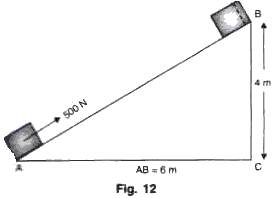
(a) Calculate the work done by the force in moving the block from A and B.
(b) Calculate the potential energy gained by the block.

Solution 8

Question 9
How fast should a boy weighting 30 kg run so that his kinetic energy is 375 joule?
Solution 9
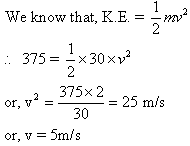
Question 10
A girl of mass 50 kg runs up a flight of 40 steps in 20 seconds. If each step in 20 cm high, calculate the power developed by the girl. (g= 10 ms-2).
Solution 10

Question 11
A water pump raises 80 kg of water through a height of 20 m in 10 s. Calculate the power of the pump.
Solution 11
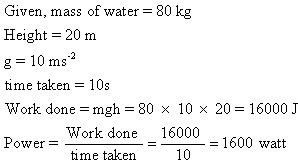
Question 12
The truck has to apply a force of 3000 N to overcome friction while moving with a uniform speed of 36 kmhr-1. What is the power developed by the truck?
Solution 12

Question 13
Define energy and state the unit of energy and the law of conservation of energy.
Solution 13
The energy of a body is its capacity to do work.
The SI unit of work is 'joules' and the CGS unit is 'erg'.
According to the law of conservation of energy, energy can neither be created nor be destroyed but can be transformed from one form to another. In other words, energy can be transformed from one form to another but the total amount of all the energies remain the same.
The SI unit of work is 'joules' and the CGS unit is 'erg'.
According to the law of conservation of energy, energy can neither be created nor be destroyed but can be transformed from one form to another. In other words, energy can be transformed from one form to another but the total amount of all the energies remain the same.
Question 14
List any six forms of energy and write a short note on each of them.
Solution 14
Six forms of energy:
1. Solar energy: The energy radiated by the sun is called the solar energy. Inside the sun, energy is produced by nuclear fusion reaction. Solar energy cannot be used to do work directly, because it is too diffused and is not always uniformly available. However, a number of devices such as solar panels, solar cells etc. have been invented to make use of solar energy.
2. Heat energy: The energy released on burning coal, oil, wood or gas is the heat energy. The stem possesses heat energy it has capacity to do work.
3. Light energy: It is the form of energy in presence of which other objects are seen. The natural source of light energy is sun. Many other sources of heat energy also give light energy.
4. Chemical or fuel energy: The energy possessed by fossil fuels such as coal, petroleum and natural gas is called chemical energy or fuel energy. These fuels are formed from the decayed remains of dead plants and animals that lived millions of years ago. In the interior of earth, due to high pressure and temperature the remains slowly changed into fossil fuels.
5. Hydro energy: The energy possessed by fast moving water is called the hydro energy. This energy is used to generate electricity in hydroelectric power stations. For this, dams are built across the rivers high up in the hills to store water. Water is allowed to run down the pipes and the energy of running water is used to turn a turbine. The turbine drives generators to produce electrical energy.
6. Nuclear energy: The energy released during the processes of nuclear fission and fusion is called nuclear (or atomic) energy. In both these processes, there is loss in mass which converts into energy in accordance with Einstein's mass-energy relation, E =mc2.
1. Solar energy: The energy radiated by the sun is called the solar energy. Inside the sun, energy is produced by nuclear fusion reaction. Solar energy cannot be used to do work directly, because it is too diffused and is not always uniformly available. However, a number of devices such as solar panels, solar cells etc. have been invented to make use of solar energy.
2. Heat energy: The energy released on burning coal, oil, wood or gas is the heat energy. The stem possesses heat energy it has capacity to do work.
3. Light energy: It is the form of energy in presence of which other objects are seen. The natural source of light energy is sun. Many other sources of heat energy also give light energy.
4. Chemical or fuel energy: The energy possessed by fossil fuels such as coal, petroleum and natural gas is called chemical energy or fuel energy. These fuels are formed from the decayed remains of dead plants and animals that lived millions of years ago. In the interior of earth, due to high pressure and temperature the remains slowly changed into fossil fuels.
5. Hydro energy: The energy possessed by fast moving water is called the hydro energy. This energy is used to generate electricity in hydroelectric power stations. For this, dams are built across the rivers high up in the hills to store water. Water is allowed to run down the pipes and the energy of running water is used to turn a turbine. The turbine drives generators to produce electrical energy.
6. Nuclear energy: The energy released during the processes of nuclear fission and fusion is called nuclear (or atomic) energy. In both these processes, there is loss in mass which converts into energy in accordance with Einstein's mass-energy relation, E =mc2.
Question 15
What do you understand by 'potential energy' and 'Kinetic energy'? Give three examples of each to illustrate your answer.
Solution 15
The energy possessed by a body by virtue of its position, shape or change of configuration is called potential energy.
Examples of potential energy:
(i) Water stored at a height in a reservoir.
(ii) A stretched spring.
(iii) A bent bow.
The energy possessed by a body by virtue of its motion is called kinetic energy.
Examples of kinetic energy:
(i) Air in motion has kinetic energy.
(ii) A swinging pendulum.
(iii) Moving hands of a clock.
Examples of potential energy:
(i) Water stored at a height in a reservoir.
(ii) A stretched spring.
(iii) A bent bow.
The energy possessed by a body by virtue of its motion is called kinetic energy.
Examples of kinetic energy:
(i) Air in motion has kinetic energy.
(ii) A swinging pendulum.
(iii) Moving hands of a clock.
Question 16
A bullet is of mass 'm' g and is moving with a velocity 'v' m/s. Find the kinetic energy of the bullet when
(a) The mass is doubled,
(b) The velocity is tripled.
(a) The mass is doubled,
(b) The velocity is tripled.
Solution 16
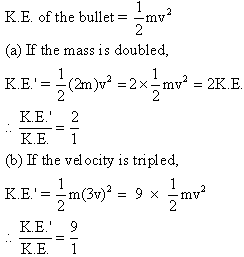
Question 17
A block of iron of mass 400 kg is used as a pile driver. If it is raised to a height of 20 meters, calculate the potential energy possessed by the iron block. (Assume g= 10 ms-2).
Solution 17

Question 18
Identify the type of energy possessed by the body in each of the following:
(a) A coiled spring of the toy car
(b) A hammer which is raised
(c) A stone shot from a catapult
(d) Water stored in the overhead tank
(e) A tadpole moving in water.
(a) A coiled spring of the toy car
(b) A hammer which is raised
(c) A stone shot from a catapult
(d) Water stored in the overhead tank
(e) A tadpole moving in water.
Solution 18
(a) Potential energy
(b) Potential energy
(c) Kinetic energy
(d) Potential energy
(e) Kinetic energy
(b) Potential energy
(c) Kinetic energy
(d) Potential energy
(e) Kinetic energy
Chapter 1 - Force, Work, Energy and Power - Exercises and MCQ Exercise 60
Question 1
Fill in the respective boxes (Fig. 13) to show the corresponding energy transformation.


Solution 1
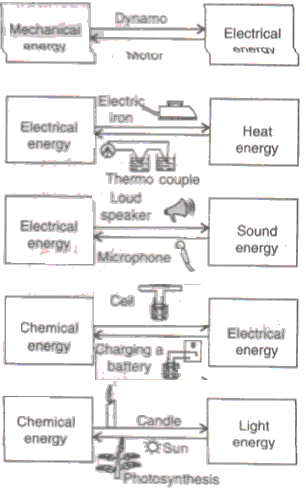
Question 2
State the energy changes which take place when
(a) Water stored in the dam is used to turn turbine in dynamo.
(b) An electric bulb glows when it is connected to a source of electric current.
(c) A piece of magnesium wire is burnt in a jar of oxygen.
(d) A stone dropped from the top of a cliff reaches the ground after some time.
(e) A toy car with a wound spring moves on ground.
(a) Water stored in the dam is used to turn turbine in dynamo.
(b) An electric bulb glows when it is connected to a source of electric current.
(c) A piece of magnesium wire is burnt in a jar of oxygen.
(d) A stone dropped from the top of a cliff reaches the ground after some time.
(e) A toy car with a wound spring moves on ground.
Solution 2

(e) P.E (Wound spring) to K.E. (motion)
Question 3
Give one example of each of the following:
(a) Electrical energy changes of sound energy.
(b) Chemical energy changes to heat energy.
(c) Chemical energy changes to electrical energy.
(d) Light energy changes to electrical energy.
(e) Electrical energy changes to heat energy.
(a) Electrical energy changes of sound energy.
(b) Chemical energy changes to heat energy.
(c) Chemical energy changes to electrical energy.
(d) Light energy changes to electrical energy.
(e) Electrical energy changes to heat energy.
Solution 3
(a) Electric bell
(b) Candle flame
(c) Dry cell
(d) Solar cell
(e) Electric iron
(b) Candle flame
(c) Dry cell
(d) Solar cell
(e) Electric iron
Question 4
Find the kinetic energy of a car of mass 1000 kg traveling at 72 km/h.
Solution 4

Question 5
A bullet of mass 25 g has a velocity of 600 ms-1. What is the kinetic energy of the bullet? If it penetrates 50 cm into a target, find the resistive force offered by the target.
Solution 5
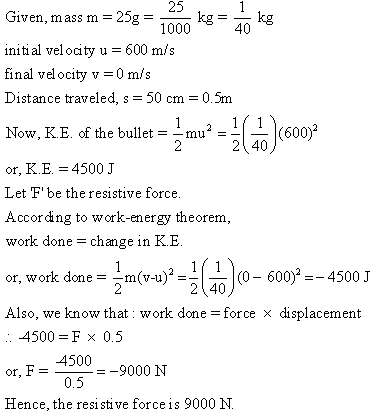
Question 6
A lead bullet moving at 70 ms-1 is brought to rest on hitting a target. If 80% of its energy is converted into heat energy, find the rise in temperature (Sp. Heat cap. Of lead is 140 J/kgK).
Solution 6
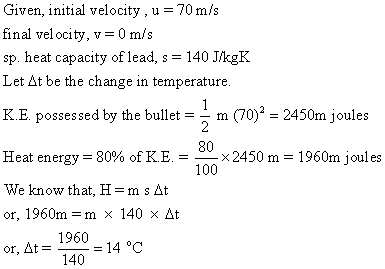
Question 7
If 60% of the potential energy available in a waterfall is converted into heat energy, find the height of the waterfall, when the temperature difference between the top and the bottom of the fall is 0.210C (sp. Heat cap. Of water = 4200J/kgK).
Solution 7
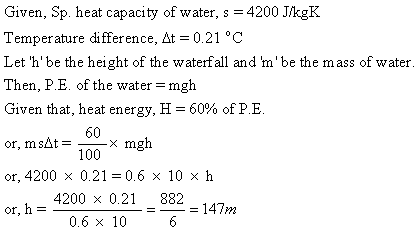
Question 8
Define the following:
(a) Simple machine (b) Lever
(c) Mechanical advantage (d) Velocity ratio
(e) Efficiency
(a) Simple machine (b) Lever
(c) Mechanical advantage (d) Velocity ratio
(e) Efficiency
Solution 8
(a) Simple machine: A machine is a device by which we can either overcome a large resistive force at some point by applying a small force at a convenient point and in a desired direction or by which we can obtain a gain in speed.
(b) Lever: A lever is a rigid, straight or bent bar which is capable of turning about a fixed axis.
(c) Mechanical advantage (M.A.): The ratio of the load to the effort is called the mechanical advantage of the machine.
(d) Velocity ratio (V.R.): The ratio of the velocity of effort to the velocity of load is called the velocity ratio of the machine.
It is also defined as the ratio of the displacement of effort to the displacement of load.
(e) Efficiency: Efficiency of a machine is the ratio of the useful work done by the machine to the work put into the machine by the effort. In other words, it is the ratio of the work output to the work input.
(b) Lever: A lever is a rigid, straight or bent bar which is capable of turning about a fixed axis.
(c) Mechanical advantage (M.A.): The ratio of the load to the effort is called the mechanical advantage of the machine.
(d) Velocity ratio (V.R.): The ratio of the velocity of effort to the velocity of load is called the velocity ratio of the machine.
It is also defined as the ratio of the displacement of effort to the displacement of load.
(e) Efficiency: Efficiency of a machine is the ratio of the useful work done by the machine to the work put into the machine by the effort. In other words, it is the ratio of the work output to the work input.
Question 9
Class I lever can have M.A. = 1, M.A. < 1 and M.A. > 1. Explain each giving examples.
Solution 9
E.g. of class I lever with M.A. = 1: A physical balance has both arms equal (i.e. effort arm = load arm), thus its M.A. = 1
E.g. of class I lever with M.A. = 1: A pair of scissors used to cut a piece of cloth has blades longer than the handle (i.e. effort arm is shorter than the load arm), thus its M.A. = 1.
E.g. of class I lever with M.A. = 1: Shears used for cutting thin metal sheets have much longer handles as compared to the blades (i.e. effort arm is longer than the load arm), thus its M.A. = 1 and it serves as a force multiplier.
E.g. of class I lever with M.A. = 1: A pair of scissors used to cut a piece of cloth has blades longer than the handle (i.e. effort arm is shorter than the load arm), thus its M.A. = 1.
E.g. of class I lever with M.A. = 1: Shears used for cutting thin metal sheets have much longer handles as compared to the blades (i.e. effort arm is longer than the load arm), thus its M.A. = 1 and it serves as a force multiplier.
Chapter 1 - Force, Work, Energy and Power - Exercises and MCQ Exercise 61
Question 1
Fig. shows a spade. It is being used to lift soil weighing 30N from the ground.
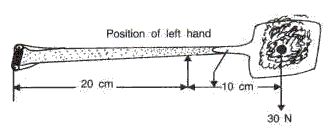
(a) Mark the direction of the least force on the handle necessary to keep the spade balanced.
(b) Calculate the least force on the handle necessary to keep the spade balanced (the weight of the spade is negligible).
(c) If the left hand was move towards the soil on the spade, would the force on the handle necessary to keep the soil balance the greater or less? Give a reason for your answer.
(d) To which class of lever does the spade belong?

(a) Mark the direction of the least force on the handle necessary to keep the spade balanced.
(b) Calculate the least force on the handle necessary to keep the spade balanced (the weight of the spade is negligible).
(c) If the left hand was move towards the soil on the spade, would the force on the handle necessary to keep the soil balance the greater or less? Give a reason for your answer.
(d) To which class of lever does the spade belong?
Solution 1
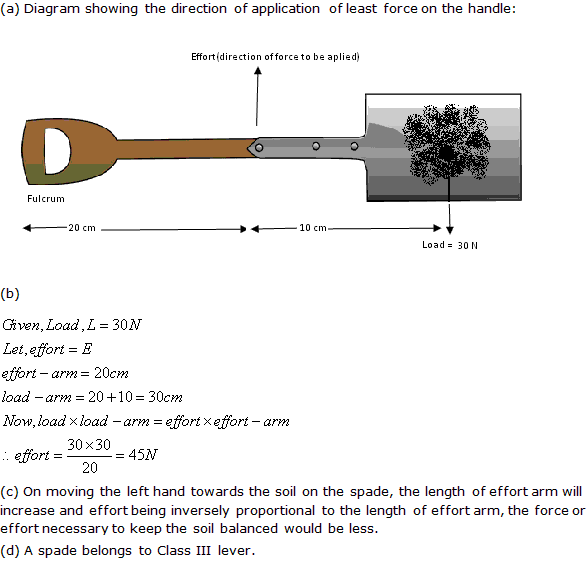
Question 2
A crowbar 4 m long has its fulcrum 50 cm from one end. What minimum effort is required to displace a weight of 500 kgf? Calculate the M.A. of the crowbar.
Solution 2

Or, E = 71.4 kgf
Question 3
A pair of nut crackers is 12 cm long. An effort of 10 gf is required to crack a nut which is passed at a point 3 cm from the finger. Calculate the load (Fig. 15).


Solution 3
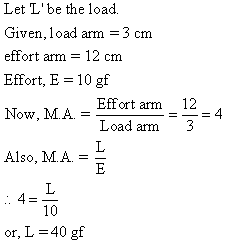
Question 4
(a) Fig. 16 represents an incomplete diagram of a simple string pulley system. Copy this diagram on a new page and complete it and mark where the effort must be applied to lift the load.
(b) What is the velocity ratio of this system?
(c) If the pulley system is 80% efficient and the load is 720 N, then
(i) What effort must be applied to lift the load?
(ii) What work must be done must be done in lifting the load through a distance of 2 m using this machine?
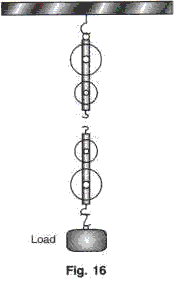
(b) What is the velocity ratio of this system?
(c) If the pulley system is 80% efficient and the load is 720 N, then
(i) What effort must be applied to lift the load?
(ii) What work must be done must be done in lifting the load through a distance of 2 m using this machine?

Solution 4

Question 5
(a) What makes a balance faulty?
(b) A faulty balance of equal arms but pans of unequal weight is used to find the weight of a body. By the method of double weighing the weights are found as 8 kg and 8.2 kg. Find the actual weight of the body.
(c) The arms of a beam balance are 20 cm and 21 cm, but the pans are of equal weight. By the method of double weighing the weights are found to be 1000 g and 20 g. Find the actual weight of the body.
(d) A faulty balance of unequal arms and pans of unequal weights is used to find the true weight of a metal. By double weighing the weights are found to be 1210 g and 1000 g. Calculate the true weight of the metal.
(b) A faulty balance of equal arms but pans of unequal weight is used to find the weight of a body. By the method of double weighing the weights are found as 8 kg and 8.2 kg. Find the actual weight of the body.
(c) The arms of a beam balance are 20 cm and 21 cm, but the pans are of equal weight. By the method of double weighing the weights are found to be 1000 g and 20 g. Find the actual weight of the body.
(d) A faulty balance of unequal arms and pans of unequal weights is used to find the true weight of a metal. By double weighing the weights are found to be 1210 g and 1000 g. Calculate the true weight of the metal.
Solution 5
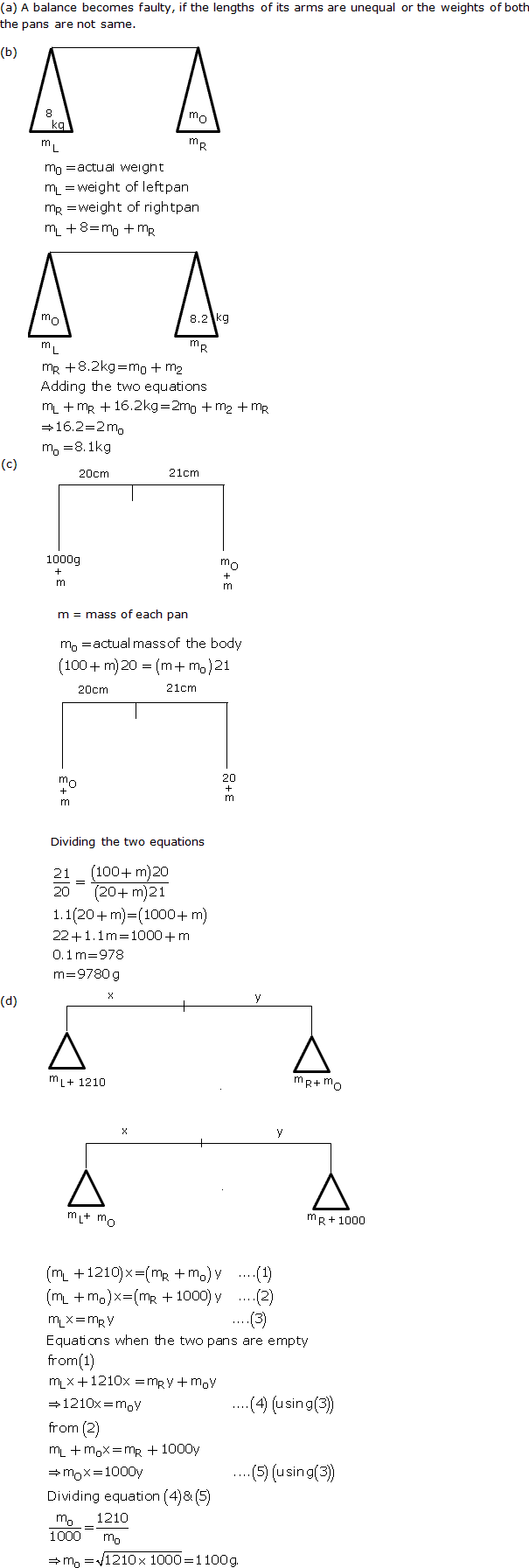

0 comments:
Post a Comment